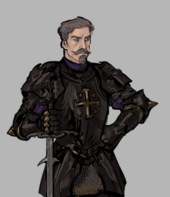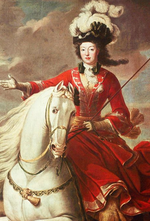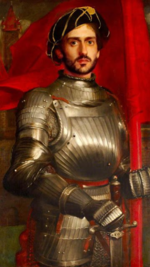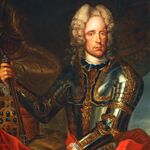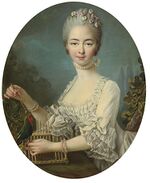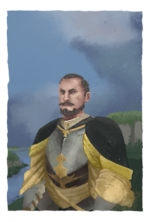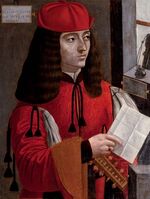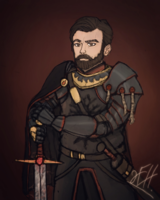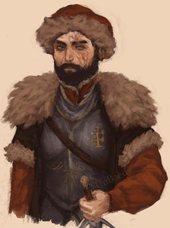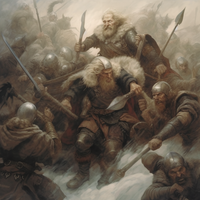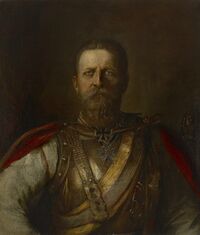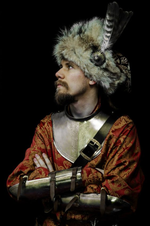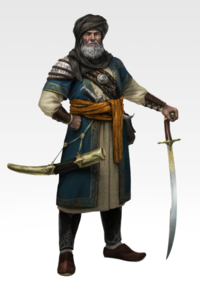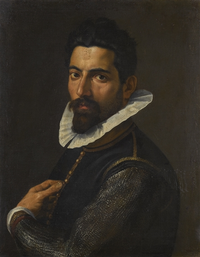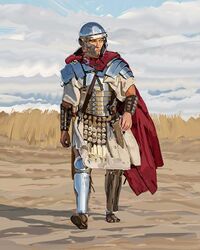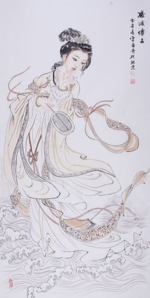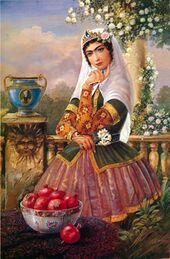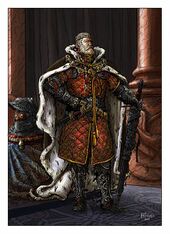Human Cultures
|
The cultures of humanity [describe]
Note: The cultures listed reflect the current actively played sphere of human cultures. For the various Nomadic and Tribal groups, see Tribal & Nomadic Cultures
Heartlander Cultures
[describe heartlanders]
| HEARTLANDERS | |
|---|---|
| RENATIAN Art by rwko.
|
A name ancient as Horen itself, Renatus, home of the Renatians, was the Kingdom to first form the Holy Orenian Empire in 1379 with the Coronation of Godfrey. Renatian men and women alike connote with a thirst for conquest and subjugation through any means, making their habitual returns to the isles one that many are frightful of. Faithful to their lands before God, but still yet to god, they are shrouded in legends of glory and dominance, with modern Renatian becoming acquainted with magic as a means of power. Renatian culture produces brilliant strategists and militant men and women, as when as a Renatian holds the throne of Oren, war is foremost in the mind of citizens. Associated with: Flexian Language, Empire of Renatus, Empire of Man |
| PETRINE
|
Petrine culture currently belongs to the Imperial Court and the House of Novellen, making it the culture of the empire and its most devoted citizens and nobility. Named for Emperor Peter III due to his reshaping of Orenian culture, petrine has long been associated with politicking statesmen, regulations, strong government, liberalization and the freedom of the people, all things it inherited from its father culture, that of the Vessian and Adrian republics. Modernized to also exude imperial regality and liberal values, Petrine culture is general to anyone within the Empire without their own culture, but especially the ruling class. Associated with: The Modern Oren, The Court of Oren |
| SAVOYARD
|
Savoyard culture is one of the oldest cultures in humanity as the inheritors of the original Esheveurd people of the ice. Called the 'sons of the sun', the culture is highly superstitious, with their adaptation of the Canonist faith bringing them to intense zealotry and conservatism, although modern Savoyard have regalized to also adopt values of grandiosity and vanity, stemming from their claim of descendance to Exalted Owyn and the Kings of Oren. Savoyard culture is known for its production of ruthless but brilliant politicians, poets and soldiers, all styled in the grandiose fashions to which Savoyard has now become synonymous thanks to their re-emergence in human society. Subcultures: Peremonti, Leuvaard Associated with: Esheveurd, Ashford Houses, Principality of Savoy |
| SEDANIAN
|
Born from the fires of Rebellion, the Sedanian culture finds its roots in Alexander II, Holy Orenian Emperor. The modern Sedanian culture was forged by Louis de Joannes during the Sedan Rebellion in an effort to unify the soldiers under his banner and to give them their own identity separate from the Petrine Orenians they fought against. Sedanian culture highly emphasizes Martial strength, and this has given birth to many skilled warriors and firm leaders such as Leopold de Joannes. In his efforts, Louis de Joannes also forged the language of Sedanari, which is still spoken by some Sedanians to this day. Because of this, Sedanians often find work as Mercenaries or Soldiers in their free time, and their work has left them revered and respected as a people. Associated with: Principality of Sedan, House de Joannes, Sedanari Language |
| AUVERGNIAN
|
TEXT ABOUT THE SETTLEMENT |
| SAVINIAN
|
TEXT ABOUT THE SETTLEMENT |
| ILLATIAN
|
TEXT ABOUT THE SETTLEMENT |
Highlander Cultures
The Highlanders are a human cultural group, made up of pioneers, yeomen, and all those who choose to live in the rougher corners of the world. Generally of a smaller and more spread population than the city dwelling Heartlanders, they lead rougher lives in the wilderness and on warpaths. The variation in their culture is great, made up of a great many nations & groups who maintain a solid nucleus of population separate from the population centers of the Heartlanders. Good examples of Highlander cultures are the Hansetian, Haense, Raevir, & Norland.
| HIGHLANDERS | |
|---|---|
| NORLANDIC Art by Daengie.
|
A culture and people which diverged from ancient Narvauk and Lakian peoples in the far North of Thales; the unification of which was rendered by Thoromir 'the Herald' Ruricsson Armahnk as the first Prophet and High Keeper of the Red Faith in 1476 FA. Thoromir's sons, the Rurikkid, would go on to rule the Norlandic people as Kings of Norland and the Red Faith would mould the mindset and actions of all Norlandic folk. It is not uncommon in Norlandic culture to find people speaking the old dialect of the Lakians, whereas the Keepers of the Red Faith maintain the use of the runic Old Norlandic language which was used in the age of Thoromir. The Norlandic people generally find themselves settling in the far Northern reaches of the land, famously upon great mountains or tall crags. The Norlandic people prioritize strategic locations and build great fortress cities upon them so as to best defend against impending sieges. Norlandic culture is known for its rustic ideals, martial prowess, and heartiness.
|
| HAESENI Art by Unbaed.
|
The Kingdom of Hanseti-Ruska traces its roots in the late 1400s during the fall of the Fourth Empire and the onset of the Schism War in 1483. The conflict resulted in fractured enclaves of Hanseti and Raevir groups joining under the leadership of Karl Barbanov, taking the ducal title as Lord of “Haense” in reference to the holy city of “Hanseh” founded by northmen under Saint Joren in the tradition of the Canonist Church. A largely martial nation, the peoples of Haense marshalled as forces under various Imperial regimes, garnering recognition for their military prowess, effective calvary, and stalwart loyalty. In 1578, the Holy Orenian Emperor bestowed onto Karl’s descendant Petyr Barbanov the titles of the Kingdoms of Hanseti and Ruska into a unified monarchy. The peoples of Haense are referred to as the “Haeseni” and are descendants of the Highlanders who have historically resided in the Northern steppes, snowy mountainous peaks, and the coniferous forests of the taiga. This terrain accommodates the prolific industries of Haense to sustain robust agricultural, equestrian, fishing, logging, and hunting industries. The Haeseni share a common national language, Naumarian (New Marian) which fuses the diverse ethnolinguistic communities that forged the heart of Haense’s society. The Haeseni are devout believers in the Holy Canonist Church with a long line of saints, High Pontiffs, and monarchs who led as Defenders of the Faith throughout human history. Defined by the national motto, “I would have perished had I not persisted,” Haeseni culture revolves around determination, willpower, and devotion to protect their homelands and the values that they have long shared together.
|
| SKANARRI
|
The Skanarri are a semi-nomadic warmongering culture of Highlanders who are an offshoot of the Norlandic Culture. As a result of their self-isolation from other cultures, the Skanarri developed their own branch of the Red Faith which still held the All-Father as the central God, yet had many other lesser gods in their pantheon. Their living area of preference is the more frigid areas of the world, often being seen in places that other descendants would see as uninhabitable. As a result of their preferred living area's scarce resources, the Skanarri are notorious for being territorial and bicker within their own society as well as with other nations. This has brought them into conflict with other cultures on more than one occasion, and almost led to their extermination during the Nyrheim Northern War. Their primary external enemy is, more often than not, the Kingdom of Norland due to the roots of the culture and their differences in religion. They have also been known to clash with the Kingdom of Haense due to their aforementioned territorial behavior. Because the Clans and Tribes of the Skanarri often bicker with each other, it is uncommon to see them united. However, they have been brought together under a "High Chieftain" or "High King" before, and when united the Skanarri are considered dangerous due to their recklessness and determination to bring wrath upon their foes. Nonetheless, their violent tendency has not always gotten in the way of interaction with other cultures as they have intermingled with other cultures before, even causing a branch of the Norlandic Eiriksson Clan to have some Skanarri blood. |
| WALDENIAN
|
The Waldenians, descendant of the Kingdom of Aesterwald, are a people known to stay in the northernmost reaches of the realm. In Almaris, almost all Waldenians are currently vassalized under the Kingdom of Haense, with the House of Barclay being apart of the Waldenian sub-culture known as Reinmaren. Associated with: Kingdom of Aesterwald, House of Barclay, House of Bishop Sub-Cultures: Reinmaren |
| ROZANIAN
|
TEXT ABOUT THE SETTLEMENT |
Farfolk Cultures
[describe farfolk]
| FARFOLK | |
|---|---|
| QALASHEEN
|
The Qalasheen are a unique and fiercely independent culture, whos ideas cause them to separate from most main-line nations and form their own. For Hundreds of years, the Qalasheen have formed Emirates, Sultanates, and even Caliphates to establish their independence as a people. Worshipping the unique Al’iiman Rashidun faith, the Qalasheen are not afraid to express their ideals nor face off with other groups for threatening them. At first led by the Kharadeen Family, the Qalasheen went on to establish great nations, and at one point during Arcas the Sultanate of Korvassa conquered and controlled vast swathes of land in the south. They tend to gravitate towards hotter environments, often settling in deserts or other relatively hot locations. Associated with: Fakhr Emirate, Al'iiman Rashidun, Sultanate of Khalestine |
| HYSPIAN
|
Not as old as many of the other cultures, but not as new as most. The Hyspians are a tan-skinned people who are highly sturdy, steadfast, and determined and whom originate from the Arcasian Wildlands. Through the many conflicts that have plagued their history both as an independent Kingdom and a vassal state, the Hyspian people have remained firm in their individual identity and are determined to conserve their culture at all costs. Associated with: Hyspanic Language, Viceroyalty of Hyspia |
| SOUTHERON
|
TEXT ABOUT THE SETTLEMENT |
| CAELIAN
|
The Caelians are a race of Farfolk people who put an emphasis on their abilities to produce legislation, their court of laws, and their abilities to field organized land armies. Typically Caelians enjoy situating themselves in fertile valleys or river beds near to arid lands which is because the diet they consume tends to be filled with crops that can grow in hot-temperate to semi-arid climates such as grapes through vineyards, Figs, Dates, Apples, Pears, Plums, cabbage, carrots, pomegranates, radishes, turnips and more. |
| LI-REN
|
The Li-Ren descend from the region of Cathant in Aeldin, settling first upon Arcas as Tai Ping tower before forming the modern Jade State of Yong Ping in Almaris. The culture of the Li-Ren is colorful, disciplined and intricate, with a society that follows the eight noble paths equally whilst dabbling in a variety of religions, primarily Huajiao and Kami worship as well as Shidoism. These main practices; Huajiao, Kami worship, and Shidoism each take a different approach to inner wellness and pursuit or rebirth and the after life. Those encompassing 'Li-Ren' are not strictly human but are a complex mixture of races that have devoted themselves to the cultural practices of their common identity. Associated with: Yong Ping, Li-Wen Language, Cathant |
| RHENYAR
|
The culture of the Rhenyar is rooted in the legacy of the Rhen - one of the seven ancient kingdoms borne with the demise of Horen. It is the region by which Highlander and Farfolk on the isle of Rhen intermingled to bear a new civilization, which alongside Shona, where Heartlander and Farfolk settled, and Ulgaard, where Highlander and Heartlander cultures came together, make up the three post-Owynite civilizations of mixed lineage. They have since migrated to become an intergral culture within a diversified Oren. The Rhenyar can be divided into three subcultures, all brought together by their common cults of astronomy, shared geography, and innovations in culture. The Rhenyar peoples as a whole identify with the stars with many noble lineages claiming a particular constellation or heavenly body as their patron. In such fashion, Canonism’s allegories to the Seven Skies made conversion for the Rhenyar swift, albeit with heterodox customs still lingering within the culture. Subcultures: North Rhenyar, Mountain Rhenyar, South Rhenyar Associated with: House Basrid, Arcane Zodiac[1] |
| AELTAROSI
|
The Aeltarosi folk are ones not native to the continent of Aevos. Instead, they hail from an island of the same name, Aeltarys, which was heavily damaged in a cataclysmic event. After the near-destruction of their homeland, a group of Aeltarosi led by Prince Maegor Valraenos fled Aeltarys and came to the continent of Failor to set up their own independent state. The Aeltarosi people are known for being some of the only humans to have naturally White hair, with skin color varying across the board. They are known for their love of Dragons and they revere the species to be sacred in their culture and religion and as a result find it hard to get along with those not of their religion such as Canonists. Although not being outwardly violent towards foreigners, Aeltarosi society is defined by two political factions; the Integrationalists who support extended culture-sharing with other human cultures, and the Purists who reject foreign traditions and prefer to preserve their own Aeltarosi traditions and customs. Thankfully for the Aeltarosi people, the so-called "Prince's Peace" prevents the two factions from attacking each other outright, and the Prince is seen as an important neutral figure. Associated with: Grand Principality of Aeltarys |
| NOTICE! If you are actively playing an unlisted human culture or are creating a new one and would like to list it here, feel free to contact a Wiki Team Member to have it included. |

